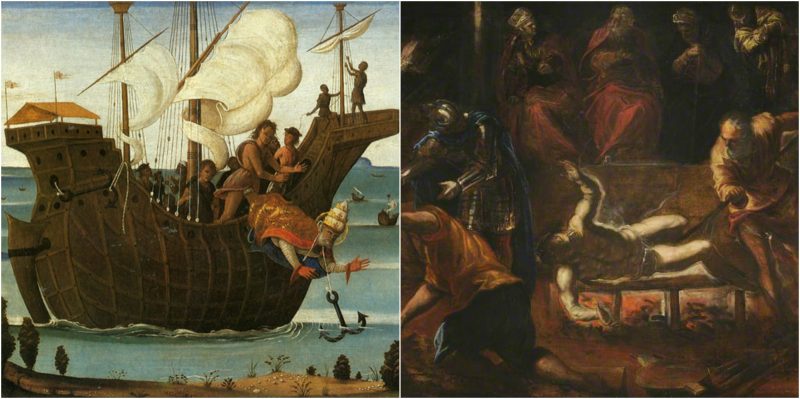To be a martyr means remaining true to what one believes in, even under the threat of death. Throughout the ages and all across the world, individuals who have expressed an unwavering faith have suffered all kinds of unimaginable tortures.
Those who suffered for their beliefs have always been venerated and have been regarded as inspirational examples for future generations. In Christianity, the people who suffered the most for their faith are now celebrated as saints. Here is a list of some of the saints who were tortured and executed in the most terrible ways.
1.Saint Lawrence – roasted alive
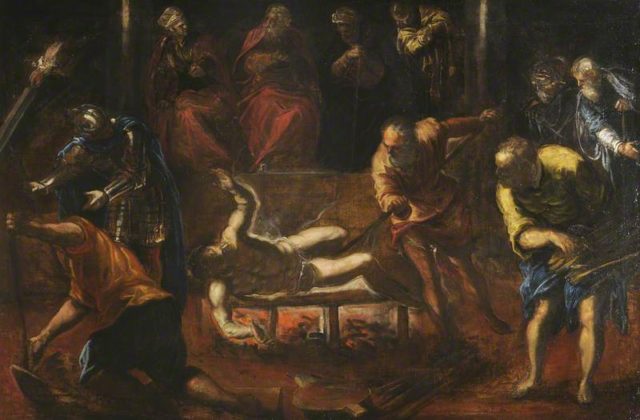
Saint Lawrence was one of the seven early Christian deacons of the city of Rome, lead by Pope St Sixtus II, who were martyred during the persecution of the Christians that took place on the orders of Emperor Valerian in 258 AD. Lawrence was the librarian and archivist of the early Christian Church. As an archivist, he was in possession of some valuable information such as the names of church members and the locations of the hidden treasures that the church owned. The legend says that Emperor Valerian captured him and gave him only two days to reveal all the treasures owned by the church. After two days, Lawrence gathered all the poor, the disabled and sick, and the orphaned Christians in front of the Palace doors and said: “These are the treasures of the Church!” Valerian was furious and decided to punish Lawrence in the most gruesome way. According to Roman tradition, those who were impudent were punished by being slowly roasted on a grill. Lawrence was brought to the site on which Basilica di San Lorenzo in Rome stands today and tied to a burning hot grill. The Romans hoped that Lawrence would publicly reveal the names of the wealthy Christians in Rome. According to stories, Lawrence endured the pain of being roasted alive and told his torturers “Turn me over. I am done on this side.” However, historical evidence suggests that Lawrence wasn’t actually roasted alive, and was, in fact, beheaded. But in spite of proof, the legend is still the accepted story. St. Lawrence is often depicted with a gridiron in his hand, as a symbol of the brutal way he was executed. St. Lawrence is also regarded as the patron saint of cooks.
2.Saint Bartholomew – skinned alive
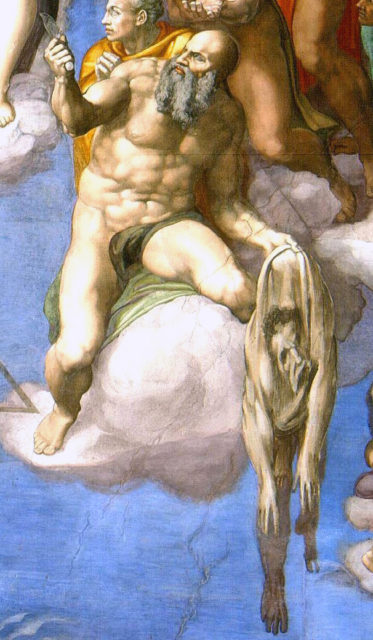
Often identified as the Apostle Nathanael, St. Bartholomew was one of the 12 Apostles that followed Jesus. He is mentioned in the Gospel of John as being introduced to Jesus by Philip the Apostle. After Christ had been resurrected, Bartholomew went to preach in India and Armenia. According to the legend, Bartholomew managed to convert Polymius, the king of Armenia, to Christianity. As a punishment for this, Astyages, Polymius’ brother, ordered Bartholomew’s execution. It is said that he was first skinned alive and then crucified upside down and left to die in excruciating pain.
In “The Last Judgment” Michelangelo drew him holding his own skin in his hand. Because of the way he was executed, St. Bartholomew became the patron saint of tanners, bookbinders, butchers, and shoemakers. He is also the Patron saint of Armenia.
3.Saint Symphorosa and her seven sons – thrown into the river, then had her seven children killed
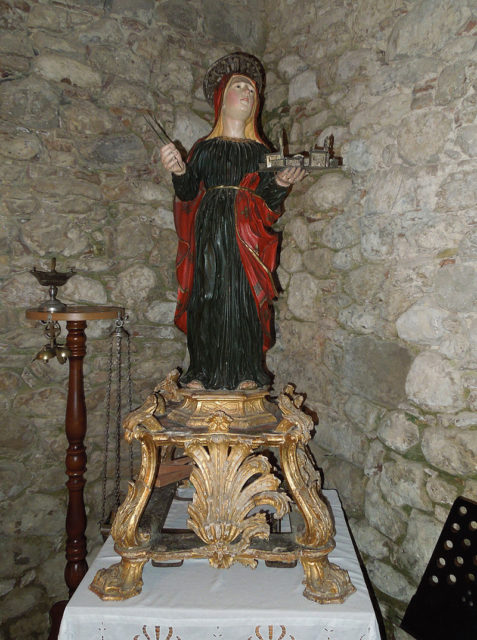
Although the authenticity of this martyrdom story hasn’t been confirmed, the execution of St. Symphorosa and her seven sons is worth mentioning because of it’s level of brutality. Symphorosa was the widow of the Tribune Getulius who was martyred by Hadrian. She and here seven sons were living in Tibur, where Emperor Hadrian built his new palace. According to the stories, the gods sent him a message in which they told him: “The widow Symphorosa and her sons torment us daily by invoking their God. If she and her children offer sacrifice, we promise to give you all that you ask for.” Hadrian approached Symphorosa asking her and her sons to offer a sacrifice to the Roman gods. After she had refused, the Emperor brought her to the temple of Hercules, tortured her, then fastened a heavy stone around her neck and threw her into the river Anio, where she drowned. This, and the execution of her husband wasn’t the only gruesome thing Hadrian did to this family; the following day, he arrested all of their seven sons, tied them to stakes around the temple and executed them one by one. Each child was executed in a different way: Crescens was pierced through the throat, Julian through the breast, Nemesius through the heart, Primitivus was wounded at the navel, Justinus was pierced through the back, Stracteus was pierced through the side, and Eugenius was split in two from top to bottom.
The place where the bodies of the children were thrown was later called “Ad septem Biothanatos.” Biothanatos was a term that pagans used for Christian martyrs and people who committed suicide.
4.St. Dymphna – beheaded by her father
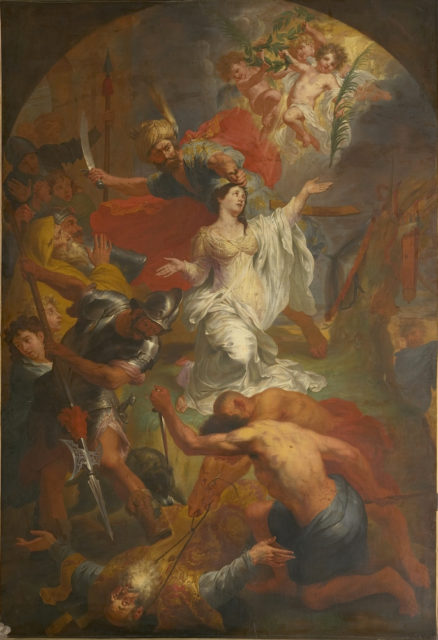
Not a lot is known about the life of St. Dymphna. According to Christian tradition, she lived sometime in the seventh century. Her father, Damon, was a lesser king in Ireland and her mother was a devoted Christian. Dymphna’s mother died when she was 14. Her father started looking for a new wife, but the thing was, he wanted to find a woman that looked exactly like his previous wife.
Unfortunately, the closest woman to what he sought was his own daughter. After hearing about her father’s intentions, Dymphna managed to escape to Belgium. After a while, her father found where she was hiding. After she refused to come back to Ireland with him, Damon took his sword and cut her head off. She was only 15 when she was killed by her father’s hand. St. Dymphna became the patron saint of the mentally ill, incest victims, and runaways.
5.Pope St. Clement – tied to an anchor and thrown into the sea
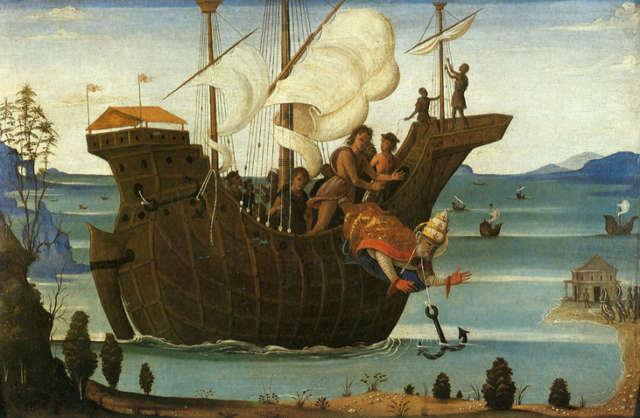
Also known as Saint Clement of Rome, he is considered to be the first Apostolic Father of the Church. St. Clement was the third successor of St. Peter in Rome, holding the title of pope from 88AD to his death in 99AD. Not much is known about his life. It is said that he had been consecrated by Saint Peter and it is clear that he was an important member of the church in Rome in the late 1st century. St. Clement is also credited as the author of an Epistle to the Corinthians written c. 96AD in the name of the Church of Rome. The letter was written as an attempt by the Church of Rome to deal with the issues of the Church of Corinth. It is regarded as one of the earliest signs of the authority and power expressed by the Church of Rome. During his life, St. Clement converted many people in the region of Rome, many of which were high-ranking and influential Roman citizens. In doing this, he caught the eye of Emperor Trajan, who exiled him to Crimea. This didn’t stop Clement from practising his faith. According to the legends, in Crimea, he performed miracles and was able to convert several thousand people to the Christian faith. When Trajan learned about Clement’s “dealings” in Crimea, he sentenced him to death by tying him to an anchor and drowning him in the sea.
6.Saint Ignatius Of Antioch – eaten by lions at the Coliseum
According to Christian Tradition, Ignatius Of Antioch was a disciple of John the Apostle. In his later years, he became the Bishop of Antioch. Ignatius lived during the reign of Emperor Trajan.
Trajan declared a law that said that Christians should be executed if somebody formally reports them, but that they were not to be hunted down and punished for no reason. Saint Ignatius probably got on the list for execution because of his public preaching.
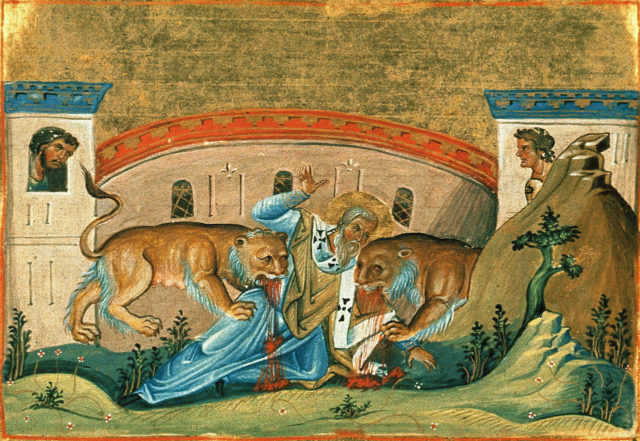
Ignatius mentions his arrest and the way he was treated in one passage from his writings: “From Syria even to Rome I fight with wild beasts, by land and sea, by night and by day, being bound amidst ten leopards, even a company of soldiers, who only grow worse when they are kindly treated.” When Ignatius was brought to Rome, Emperor Trajan ordered that lions should eat him at the Coliseum. On the last day of the gladiator games, they threw Saint Ignatius into the arena where two hungry lions devoured him in a minute.
7.Saint Phocas of Sinope – thrown into a kiln then boiled alive
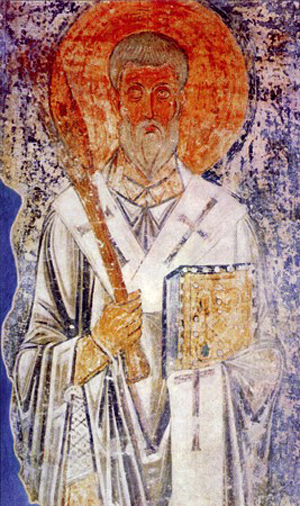
Not much is known about his life except that he was from the city of Sinope. In his later years, he became the Bishop of the city. Like Saint Ignatius, Phocas was spreading Christianity during the reign of Trajan. When Trajan started his persecutions, Phocas was arrested and executed. His execution was terrible. They first threw him into a burning lime kiln – a kiln used for quicklime production, where temperatures reach more than 1652 degrees Fahrenheit.
Miraculously, Phocas survived the searing heat. His executioners then threw him into boiling water where he succumbed and died. In Christianity, Saint Phocas is celebrated as the defender against fires and as the helper of people that are drowning.
8. Simon the Zealot – crucified upside down and sawn in half

Simon, the Zealot, sometimes known as Simon the Cananean, was one of the 12 apostles. According to legend, Jesus and his followers came to Simon’s wedding. There, Jesus performed a miracle, turning water into wine. This act convinced Simon to abandon his house, together with his family, and join Jesus. There are several different accounts of his death. According to one of the stories, Simon the Zealot went to spread Christianity in Persis where he was captured, crucified upside down, and then slowly cut in half with a saw. Although this method of execution is mentioned in many cases from ancient times, it hasn’t been proved whether it was really used on anybody. Still, it sounds like a terrible thing to do to somebody. Because of this legend, Simon is often depicted with a saw in his hand.
9. Saint John de Brebeuf – Scalped and eaten alive in front of his eyes
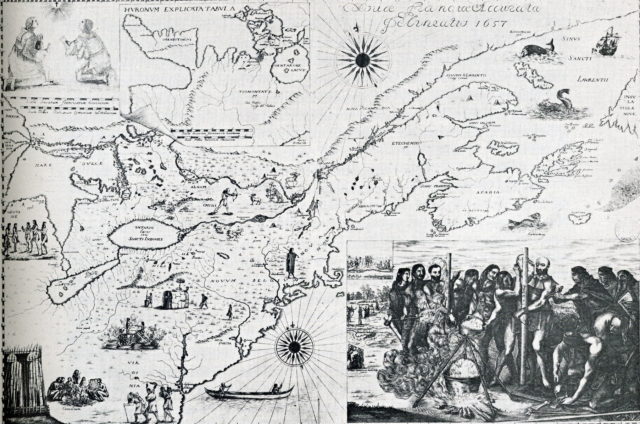
Saint John de Brebeuf is one of the more recent additions to the long list of Christian saints, he was martyred on March 16, 1649, and beatified in 1925. John de Brebeuf was a French Jesuit missionary who, in 1625, was sent to New France (the French colony that would later become part of Canada). During his mission to spread Christianity among the native population, he was captured by the Iroquois. Saint John de Brebeuf was then scalped, but this wasn’t the only thing the tribe did to him.
After scalping him, they began to slowly cut pieces from his body and eat his flesh in front of his own eyes. After they had finished eating him, they poured boiling water over him and finished him off with red-hot hatchets. Since 1940, Saint John de Brebeuf is celebrated as one of the patron saints of Canada.
10. Hippolytus of Rome – torn apart by wild horses
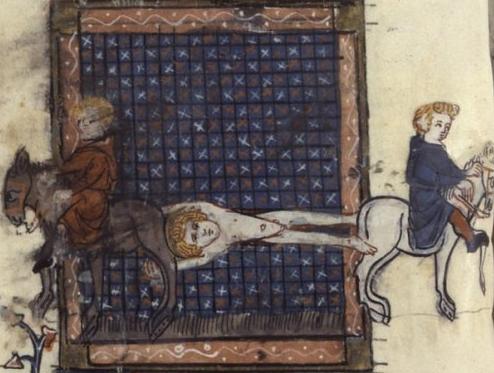
In the third century, Saint Hippolytus was one of the most influential figures in the Christian Church of Rome. His identity is often mixed with another saint who bears the same name and was executed by drowning in a deep well. This Hippolytus, however, according to some scholars, was a soldier who was present at the execution of Saint Lawrence. Hippolytus was appalled by the way Saint Lawrence was executed and decided to accept the Christian faith as a way to redeem himself. According to the legend, he was arrested and sentenced to be torn apart by wild horses. This story of Saint Hippolytus is very similar to the ancient Greek myth about Hippolytus, the son Theseus, also known as the “unleasher of horses,” who was dragged to death by horses in Athens. Because of this resemblance, we cannot know for certain if this is the way he was really killed. Saint Hippolytus of Rome is often venerated as the protector of horses.
11. Saint Andrew Bobola
Saint Andrew Bobola is another late addition to the list of saints. This Polish missionary was sent on numerous missions across Lithuania, and his work there earned him the nickname “Apostle of Lithuania.”
Andrew Bobola became a martyr after he was captured and executed during the Cossack-Polish War in 1657. Bobola was captured in the village of Janów (present day Ivanava, Belarus) by the Cossack troops of Bohdan Chmielnicki. Saint Andrew Bobola suffered a lot during his days in captivity.
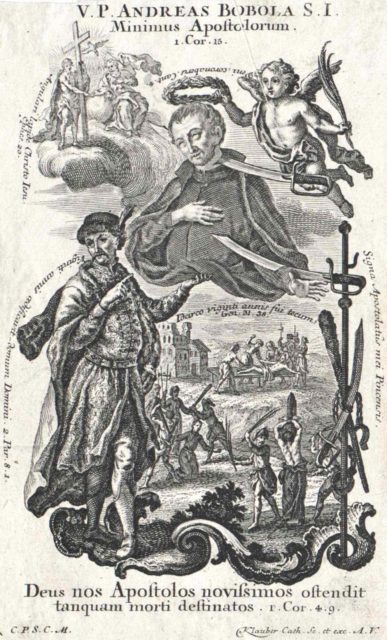
First, he was tied to a tree and “scourged.” Scourging was a torture technique that involved whipping a person with a whip that has bones or metal pieces attached to its end which leave deep wounds on the body. Later, they put a thorn crown on his head, took out one of his eyes and slowly burned his body with torches. But this wasn’t all; one of the torturers cut out a piece of his skin in the shape of a chasuble vest (a vest worn by priests) and then peeled it from his body. They continued by sticking needles beneath his fingernails. According to the story, while his torturers tormented him, Saint Andrew Bobola didn’t stop praying for their souls. Tired of his constant prayers, they cut out his tongue and then executed him by crushing his skull.
12. Saint Catherine – broken on the wheel

According to Christian tradition, Catherine of Alexandria was a virgin, princess, and a scholar who, after receiving a vision of the Madonna and Christ, accepted the Christian faith. Saint Catherine lived during the reign of emperor Maxentius, and her father was Costus, the Roman governor of Alexandria at that time. According to the legend, Saint Catherine visited the emperor and tried to convince him to stop prosecuting the Christians. Her attempt was unsuccessful, but she did manage to convince the emperor’s wife to convert to Christianity. Maxentius tried to convert Catherine back to the old ways by sending 50 of his best scholars, but she managed to convert most of them to her faith.
The emperor then decided that she should be arrested and executed. Saint Catherine’s execution was performed on the so-called “breaking wheel,” a notorious torturing device that became one of the favorite methods of execution in the Medieval period. The legend says that when Saint Catherine’s body was placed on the breaking wheel (a large wooden wagon wheel), the wheel broke into pieces. After they had been unable to execute her in this manner, Catherine was beheaded. Saint Catherine is celebrated as one of the great martyrs of the Eastern Orthodox Church, and she is venerated as one of the Fourteen Holy Helpers in the Catholic Church.
13. Saint Agnes of Rome: sent to a brothel, condemned to be burned, then stabbed with a sword
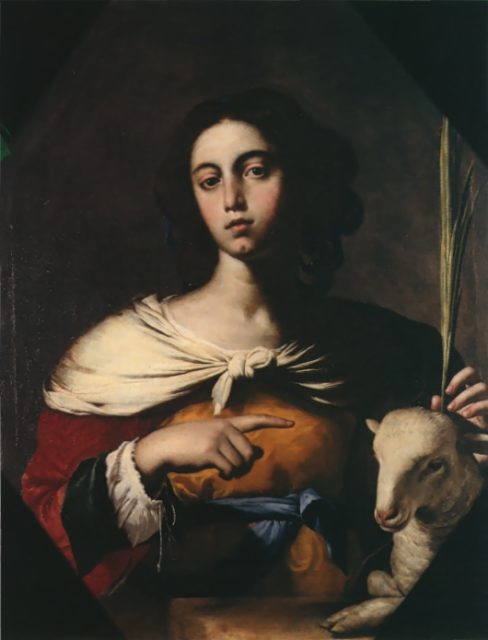
Saint Agnes, also known as Saint Inés, was a Roman noble girl born around 291 A.D., during the rule of Emperor Diocletian. Agnes was born and raised in a wealthy Christian family, and she was also very beautiful. She already had many powerful and influential suitors in Rome at 12 years old, but as a devoted Christian and wanting to keep her virginity and purity, Agnes turned them down. According to the stories, she was reported to the authorities as a follower of the Christian faith by one of her insulted suitors.
Phocus, the son of a Roman prefect called Sempronius, told his father about her faith. Sempronius questioned her, and she publicly admitted that she was following Christianity, and after she had refused to offer a sacrifice to the temple of the goddess Vesta, she was arrested, stripped naked and dragged to a brothel. The legend says that while she was dragged naked through the streets, her hair miraculously grew and covered her body. The miracles didn’t stop. At the brothel, her faith protected her, and she managed to stay a virgin. After hearing about this, the authorities condemned her as a witch and decided to burn her at stake. However, when they tried to light the bundles of wood, they wouldn’t burn; then, one of the soldiers drew his sword and stabbed her in the throat. Saint Agnes became the patron saint of chastity, girls, engaged couples, rape survivors, and virgins.
14. Saint Eulalia – tortured in thirteen different ways
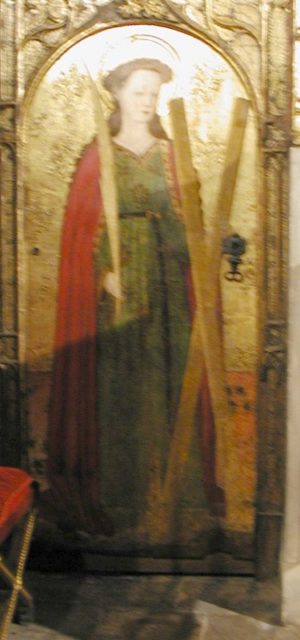
Saint Eulalia, whose martyrdom is often mixed up with that of Saint Eulalia of Mérida (sometimes considered to be the same person), was a 13-year-old girl from Barcelona who lived during the reign of Diocletian. She was captured during the prosecution of Christians ordered by the Emperor. After Eulalia had refused to deny her faith, she was given an unimaginably terrible punishment – to be tortured in thirteen different ways, one for every year of her life.
Part of her torture included her being stuffed into a barrel full of sharp glass pieces and then rolled down a street. Allegedly, that street still exists in Barcelona today, and it is called “Saint Eulalia’s descent” (Baixada de Santa Eulalia). They also cut off Saint Eulalia’s breasts and crucified her on an x-shaped cross. At the end of her torture, Eulalia was beheaded.
15. Saint Victor Maurus – ground to death in a stone mill
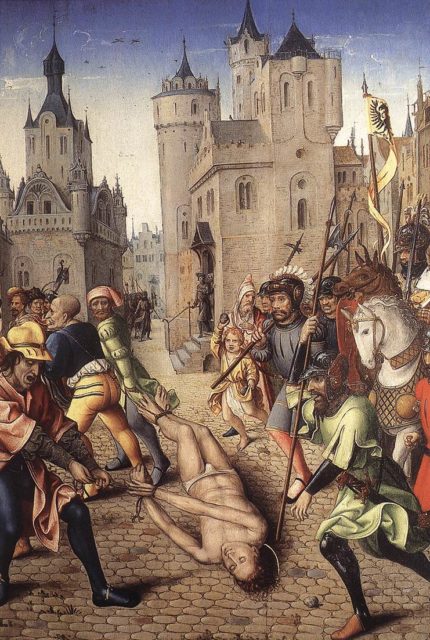
There is little information about Victor’s life. He was born in the third century in Mauretania, and he was raised as a Christian. According to some records, he was a Roman Praetorian guard. The legend says that when Victor Maurus arrived in Milan, Italy, around 303 AD, he secretly started to spread Christianity among the population.
Eventually, he was discovered, arrested, and dragged through the streets. He was repeatedly beaten and stretched on the rack (the torturing device). During this time, he even managed to convert three of his guards. Soon, the word about his unwavering faith reached Emperor Maximilian. He immediately beheaded the converted soldiers and then tortured Victor on the rack again. Saint Victor Maurus was then offered the chance to sacrifice incense on an altar of Jupiter, but he declined and knocked down the altar. As a punishment for his sacrilege, Maximilian ordered his men to cut off the foot that destroyed the altar. After being unable to defeat Victor’s faith, his captors threw him into a stone mill where he was crushed to death.
